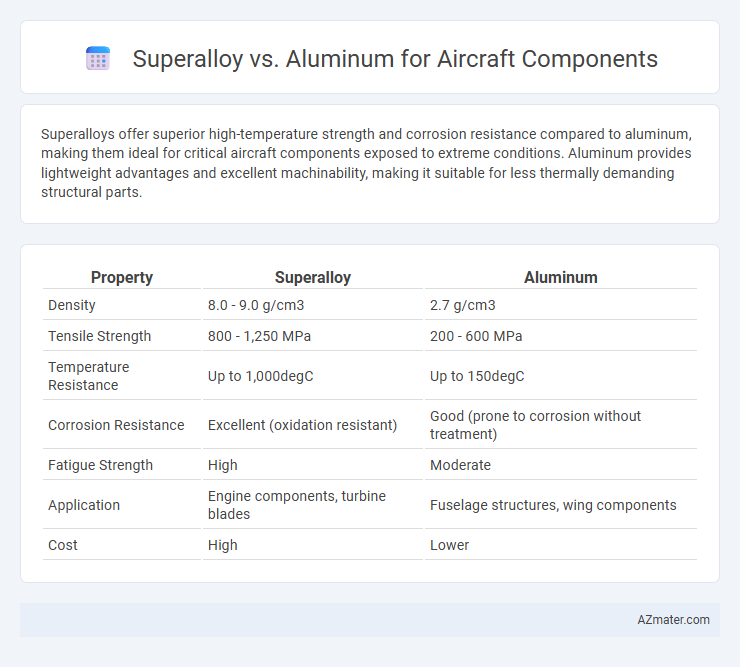Superalloys offer superior high-temperature strength and corrosion resistance compared to aluminum, making them ideal for critical aircraft components exposed to extreme conditions. Aluminum provides lightweight advantages and excellent machinability, making it suitable for less thermally demanding structural parts.
Table of Comparison
| Property | Superalloy | Aluminum |
|---|---|---|
| Density | 8.0 - 9.0 g/cm3 | 2.7 g/cm3 |
| Tensile Strength | 800 - 1,250 MPa | 200 - 600 MPa |
| Temperature Resistance | Up to 1,000degC | Up to 150degC |
| Corrosion Resistance | Excellent (oxidation resistant) | Good (prone to corrosion without treatment) |
| Fatigue Strength | High | Moderate |
| Application | Engine components, turbine blades | Fuselage structures, wing components |
| Cost | High | Lower |
Introduction to Superalloys and Aluminum in Aviation
Superalloys, primarily composed of nickel, cobalt, or iron, exhibit exceptional high-temperature strength and corrosion resistance crucial for critical aircraft components such as turbine blades and engine parts. Aluminum alloys are favored in aviation for their lightweight properties, excellent machinability, and good corrosion resistance, making them ideal for airframe structures and exterior panels. The selection between superalloys and aluminum balances performance demands, with superalloys excelling in extreme thermal environments and aluminum providing weight savings to enhance fuel efficiency.
Key Material Properties: Superalloys vs Aluminum
Superalloys exhibit exceptional high-temperature strength, corrosion resistance, and creep resistance, making them ideal for critical aircraft engine components exposed to extreme thermal and mechanical stresses. Aluminum alloys offer lightweight properties, excellent machinability, and good corrosion resistance, which contribute to overall fuel efficiency and structural integrity in airframe applications. The choice between superalloys and aluminum depends on component-specific requirements for thermal endurance, weight savings, and mechanical performance in aerospace design.
Strength and Weight Considerations
Superalloys exhibit exceptional strength and high-temperature resistance, making them ideal for critical aircraft components exposed to extreme stress and heat, such as turbine blades and engine parts. Aluminum alloys offer a significantly lighter weight, enhancing fuel efficiency and overall aircraft performance while providing adequate strength for less critical structural parts like fuselage and wings. Balancing the superior strength of superalloys with the lightweight advantage of aluminum is essential for optimizing aircraft design and operational efficiency.
Corrosion Resistance and Durability
Superalloys exhibit superior corrosion resistance compared to aluminum, making them ideal for aircraft components exposed to extreme environments, including high temperatures and aggressive chemical conditions. Their enhanced durability stems from high tensile strength and creep resistance, ensuring long-term performance and structural integrity under mechanical stress. Aluminum alloys, while lightweight and cost-effective, generally require protective coatings to mitigate corrosion and do not match the longevity of superalloys in harsh aerospace applications.
Temperature Resistance and Performance
Superalloys exhibit superior temperature resistance compared to aluminum, maintaining structural integrity and mechanical strength at temperatures exceeding 700degC, essential for high-performance aircraft components exposed to extreme heat. Aluminum alloys, while lightweight and corrosion-resistant, typically lose strength above 200degC, limiting their use in high-temperature areas such as engine parts or exhaust systems. The enhanced high-temperature performance of superalloys ensures reliable operation and longevity in critical aerospace applications where thermal stress is a key concern.
Cost Analysis: Superalloy vs Aluminum Components
Superalloy components typically incur higher manufacturing and material costs compared to aluminum due to their complex alloying elements and specialized processing requirements, which enhance temperature and corrosion resistance in aerospace environments. Aluminum offers cost-effective fabrication and lighter weight, reducing fuel consumption and overall operational expenses, but may require more frequent maintenance or replacement under extreme stress conditions. Evaluating cost analysis for aircraft components involves balancing the upfront investment in superalloys against aluminum's lower initial cost and its impact on long-term performance and lifecycle expenses.
Machinability and Manufacturing Challenges
Superalloys present significant machining challenges due to their high strength, hardness, and tendency to work-harden, resulting in increased tool wear and slower cutting speeds during aircraft component manufacturing. Aluminum offers superior machinability with lower cutting forces, higher feed rates, and less tool degradation, making it easier and more cost-effective to machine for aerospace applications. The complex microstructure and thermal stability of superalloys require specialized cutting tools and techniques, whereas aluminum's lightweight and ductile nature streamline production but may compromise high-temperature performance.
Applications in Aircraft: Where Each Material Excels
Superalloys excel in high-temperature applications such as turbine blades and engine components due to their exceptional strength, thermal stability, and corrosion resistance. Aluminum is preferred for airframe structures including wings and fuselage panels because of its lightweight nature, good fatigue resistance, and ease of fabrication. Choosing between superalloy and aluminum depends on the specific aircraft component requirements, balancing performance under extreme conditions against weight efficiency.
Environmental Impact and Sustainability
Superalloys, primarily composed of nickel, cobalt, and chromium, offer superior heat resistance and durability for aircraft components but have a higher environmental footprint due to energy-intensive mining and processing. Aluminum, extensively used in aviation for its lightweight and recyclability, significantly reduces fuel consumption and carbon emissions over the aircraft lifecycle, making it a more sustainable choice. Recycled aluminum maintains nearly 95% of its original strength, sharply minimizing waste and resource depletion compared to the extraction-intensive production of superalloys.
Future Trends in Aircraft Material Selection
Superalloys, known for exceptional high-temperature strength and corrosion resistance, remain critical in engine components, while aluminum alloys, prized for lightweight and ease of fabrication, dominate airframe structures. Emerging trends emphasize hybrid materials and advanced composites to enhance performance and fuel efficiency, with superalloy development focusing on improved thermal stability and aluminum alloys targeting increased strength-to-weight ratios. Future aircraft designs prioritize integrating these materials with additive manufacturing and nano-engineered enhancements to optimize durability and reduce environmental impact.

Infographic: Superalloy vs Aluminum for Aircraft component
 azmater.com
azmater.com